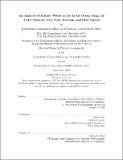An analysis of Atlantic water in the Arctic Ocean using the Arctic Subpolar gyre state estimate and observations
Author(s)
Grabon, Jeffrey Scott,Lieutenant Commander.
Download1227040895-MIT.pdf (10.05Mb)
Other Contributors
Joint Program in Physical Oceanography.
Massachusetts Institute of Technology. Department of Earth, Atmospheric, and Planetary Sciences.
Woods Hole Oceanographic Institution.
Advisor
John Toole.
Terms of use
Metadata
Show full item recordAbstract
The Atlantic Water (AW) Layer in the Arctic Subpolar gyre sTate Estimate (ASTE), a regional, medium-resolution coupled ocean-sea ice state estimate, is analyzed for the first time using bounding isopycnals. A surge of AW, marked by rapid increases in mean AW Layer potential temperature and AW Layer thickness, begins two years into the state estimate (2004) and traverses the Arctic Ocean along boundary current pathways at approximately 2 cm/s. The surge also alters AW flow direction and speed including a significant reversal in flow direction along the Lomonosov Ridge. The surge results in a new quasi-steady AW flow from 2010 through the end of the state estimate period in 2017. The time-mean AW circulation during this time period indicates a significant amount of AW spreads over the Lomonosov Ridge rather than directly returning along the ridge to Fram Strait. A three-layer depiction of ASTE's overturning circulation within the AO indicates AW is converted to colder, fresher Surface Layer water at a faster rate than is transformed to Bottom Water (1.2 Sv vs. 0.4 Sv). Observed AW properties compared to ASTE output indicate increasing misfit during the simulated period with ASTE's AW Layer generally being warmer and thicker than in observations.
Description
Thesis: S.M., Joint Program in Physical Oceanography (Massachusetts Institute of Technology, Department of Earth, Atmospheric, and Planetary Sciences; and the Woods Hole Oceanographic Institution), 2020 Cataloged from student-submitted PDF of thesis. Includes bibliographical references (pages 91-94).
Date issued
2020Department
Joint Program in Physical Oceanography; Massachusetts Institute of Technology. Department of Earth, Atmospheric, and Planetary Sciences; Woods Hole Oceanographic InstitutionPublisher
Massachusetts Institute of Technology
Keywords
Joint Program in Physical Oceanography., Earth, Atmospheric, and Planetary Sciences., Woods Hole Oceanographic Institution.